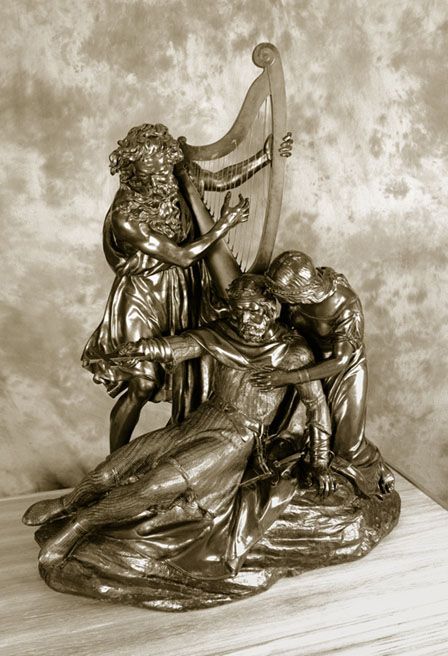The death of Tewdric Mawr - King of Gwent

This sculpture depicts the death of Tewdrig Mawr, saint and King of Gwent and Morgannwg, who died at the moment of victory over the Saxons at Mathern, around 630AD.
The composition originated as a plaster shown at the Abergavenny Eisteddfod in 1848. This was subsequently shown at the Royal Academy in 1849. A bronze electrotype of it was exhibited by Elkington, Mason & Co. in the Great Exhibition of 1851.
Two casts are known today, both also made by Elkington’s. The other is on display in the Brecknock Museum. This one, which is dated 1856, was given by a group of subscribers to Morris C. Jones, editor of the Montgomery Collections, in 1876. A brass plate recorded:
‘This bronze group represents the death of Tewdric Mawr, King of Gwent and Morganwg 610 AD. Tewdric Mawr, in his old age, was induced to appear in defence of his country against the Saxons whom he thoroughly vanquished near the junction of the Severn and the Wye. The Welsh King, though mortally wounded, urged his brave followers to pursue the fleeing Saxons. In his dying moments he was comforted by his daughter Marchell, mother of Brychan, while an aged Bard proclaimed to him by harp and song, the victory. The group was designed, from suggestions by Lady Llanover, by the late John Evan Thomas F.S.A. and modelled by his brother W. Meredyth Thomas Medal Student RA. Elkington & Co. fect, Liverpool.’
The sculptor John Evan Thomas was born in Brecon in 1810. He studied under Sir Francis Chantrey and on the Continent. He produced the first of many church monuments in 1831, and began to practice as a portrait sculptor in London in 1834.
He established a studio at 7 Lower Belgrave Place, from which he frequently exhibited portrait busts at the Royal Academy until 1862. Despite his move to London, Thomas retained close links with the gentry of his home town and with the principal Welsh landed families, many of whom were to sit for him. Consequently he was the first Welsh sculptor to establish a significant career and reputation largely through Welsh patronage.
Thomas’s principal works are a statue of the 2nd Marquess of Londonderry (Westminster Abbey), a statue of the 2nd Marquess of Bute (also exhibited in Great Exhibition and cast in bronze in 1853, now in Cardiff city centre), Sir Charles Morgan (Newport), a memorial to the 1st Duke of Wellington (Brecon), John Henry Vivian (Swansea) and the statue of the Prince Consort erected on Castle Heights, Tenby, in 1865.
Although principally a portrait sculptor, he contributed mediaevalising statues of Henri de Londres, Archbishop of Dublin, and of William, Earl of Pembroke to Pugin’s scheme for the rebuilt House of Lords in 1848.
Described by Benedict Read as the ‘only unqualified example of ideal sculpture with history as a subject matter’, The Death of Tewdric is a significant episode in mid-Victorian art. It is also of fundamental importance in the context of the Welsh national revival of the 1830s and 1840s, being the principal work of art to emerge from the triennial Abergavenny eisteddfodau patronised by Lady Llanover. Peter Lord calls it ‘the most notable example of national academic art in the first half of the 19th century’.
The Death of Tewdric also appears to have been the largest work exhibited by Elkington, Mason & Co. at the Great Exhibition in 1851, employing the firm’s newly invented electrotype process. Both the bard (derived from the well-known de Loutherbourg print of 1784) and his harp are formed as separate sections, and are bolted to the base.
The Death of Tewdric, 1848–56
- Bronze, height 167 cm (65 inches), length 127 cm (50 inches), width 63 cm (25 inches)
- Signed: I EVAN THOMAS Sc and Elkington Mason & Co fect 1856
- Bronze, cast by Elkington & Co, Birmingham and Liverpool
Comments - (2)
Dear Andrew Jones,
Thank you very much for spotting this error; we have now corrected it.
Best wishes,
Marc
Digital Team